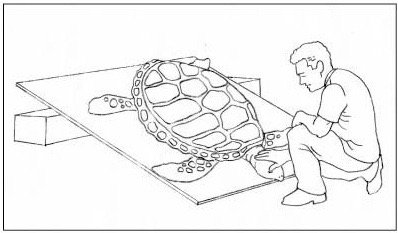Turtle Recovery and Release
A newly dehooked and/or disentangled turtle may be stressed or exhausted by its ordeal. Thus, allow it to rest (for example, on a tire) for a few hours until it starts moving again before releasing it.
- Keep the animal at a temperature above 15°C (59°F) but never over 30°C (86°F).
- Also keep it moist (cover the body—but not nose and mouth—with a wet towel, or spray it periodically with water) and under shade when the temperature is above 24°C (59°F).
When you are ready to return the turtle to sea, take the following steps:
- Check that there is no fishing gear in the water
- Bring the vessel to a stop
- Put the engine in neutral to disengage the propeller
- Ease the turtle into the water headfirst while holding it by the sides of its shell. If your vessel has a side door, releasing the turtle from the open door is a good option
Turtle release in Alcantara, Cebu, Philippines (Photo: Steve De Neef)
Do not drop or throw the turtle from a great height. Make sure the turtle is a safe distance from the boat before you reengage the propeller.
If the turtle appears unconscious (possibly due to entanglement underwater), place the turtle on a tilted surface so that its hindquarters are approximately 15 cm (6 in) higher than its head. This allows water to drain out of its lungs.
Never place an unconscious turtle on its back. The lungs in turtles are located immediately under the carapace. As a result, turning a turtle upside down will cause all the organs (stomach, intestines, liver, etc.) to fall over the lungs, preventing the animal’s breathing.
Keep the animal moist (with a damp towel over its shell) if temperatures are over 24° C (75° F), or keep it inside if cold. Check the turtle’s reflexes by touching its tail or eyelid every three hours.
Once the animal recovers and starts moving and breathing, release it gently into the water. An unconscious, but live, turtle may not react. If, after 24 hours, the turtle still shows no reflex reaction, it is likely dead.
If the turtle appears unconscious (possibly due to entanglement underwater), place the turtle on a tilted surface so that its hindquarters are approximately 15 cm (6 in) higher than its head. Check the turtle’s reflexes by touching its tail or eyelid every three hours.
As a skipper, you are already familiar with handling tools and animals. But instead of landing fish, you can use this knowledge to ensure the survival of these vulnerable sea turtles.




